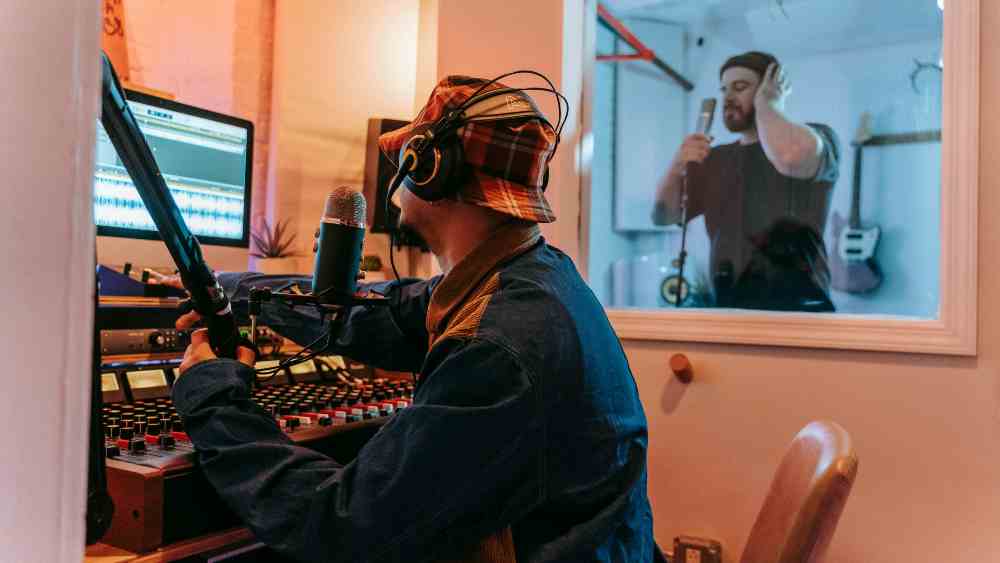“To infinity and beyond!” If you’ve ever dreamed of becoming the voice behind an iconic character like Buzz Lightyear, you’re not alone. Voice acting is a dynamic and rewarding career that allows you to bring stories and characters to life with just your voice. Whether you’re passionate about animation, video games, or commercials, this guide will help you navigate the steps to become a successful voice actor.
Voice actors are like any screen actors; they use their acting skills to entertain audiences. The only difference is that a vocal artist never appears on screen. Now when you think of voice acting, you might just think of famous celebrities voicing animated characters on film and television. But voiceover work covers a huge range of categories, including corporate training videos, audiobooks, video games, and wellness apps.
With the world aggressively embracing digital, the global online content industry is expected to surpass a whopping $181.4 billion by 2032, as per a Market.us report, creating more opportunities than ever for voice actors.
So if you’re passionate about acting and have a distinct voice, this might just be your calling. But let’s not get ahead of ourselves! Let’s first understand what voice acting is all about.
Understanding Voice Acting
What is Voice Acting?
Voice actors lend their voices to bring a diverse range of media to life. Although voice actors read words out loud, this skill requires talent, experience, and versatility.
Voice actors use their vocal skills to bring cartoons and video game characters to life. Many voice actors also lend their talents to radio and television commercials and movie trailers.
Even though you don’t see them or know them, voice plays a hugely important role in selling a product or the emotional beat of the character being played.
Voice acting is a recognized career for people who specialize in it. However, it is also a fantastic way for classically trained actors to make money between stage, television, or film roles. More recently, famous actors like Jack Black, Chris Pratt, and Cameron Diaz have taken to lending their voices to big Hollywood animated productions and mainstream television shows.
WATCH: How to Write Great Dialogue
Voice Acting vs. Voiceover

Although the terms are used interchangeably, there is a slight difference between voice acting and voiceovers. Voice talent refers to voice actors and voiceover artists and is often used by agencies and hiring companies.
A voiceover is a production procedure where an actor’s voice is recorded to be used off-screen. Although it can be used in movies, animated TV shows and games, it is more commonly used in commercials and non-fiction.
Voice acting is a part of the voiceover process in which actors or voice artists use their vocals to bring a character to life, impart information, or offer entertainment.
The key difference between voiceovers and voicer acting is that one is part of the production process while the other is a skill. Being a voiceover artist is a much broader skill, unlike voice acting, which requires patience and a specific talent.
How To Become a Voice Actor

Step 1: Build Voice Acting Experience
Like any career, laying a good foundation for yourself as a successful voice actor takes devotion, patience, and acting experience. Mastering voice acting isn’t just about vocal ability and being able to talk. It requires a range of skills, and like any other skill, it needs to be honed.
It is worth investing some time and a little money into your career at this initial stage rather than diving headfirst into the industry. For example, taking acting classes or working with a coach can help you develop the vocal techniques you require.
Step 2: Practice and Voice Acting Classes
Having a naturally good voice is not enough to get you to work; it takes practice and training. You’ll need to learn the different voice styles and the technical nuances of each. The best way to do this is to work with a voice coach and vocal acting classes.
A voice coach or voice acting classes will help you expand your knowledge of the skill and the techniques required to make it. A professional coach can practically take you through various voiceover styles in a way that may not be possible to learn from a book/written material.
He’ll help you practice changing your range and cadence and experiment with character voices. Practising around a trained and experienced person means you will get direct feedback from someone you trust.
Mentors can be your biggest ally, but they’ll also be quick to highlight where you’re going wrong. Unlike friends and family, they won’t sugarcoat feedback, which can restrict your growth.
Step 3: Finding Your Voiceover Niche
If you want to become a voice actor, there are several genres you can pick from. For a long and successful career in the industry, it’s important to find your niche. It’s vital you know the product you have to offer, as well as your strengths and weaknesses.
Working with an acting coach or taking classes will help you to understand what comes naturally to you and understand the type of work you enjoy doing. It’s not just about what professional voice you like doing; it’s also about understanding your weaknesses and determining if you can sustain an accent or style throughout an entire project.
People will hear it in your voice if you have a genuine interest in a certain genre, whether it’s becoming an animated voice actor, reading audiobooks or narrating commercials. Do your research and engage in existing voice work in different areas of the industry to understand your niche. The more you know about the genre and your voice, the better you will be at your job.
It’s all about finding your strength and understanding the needs of the genre. If you are good at creating character voices and sustaining accents for longer periods of time, animations and audiobooks could be the ideal direction. If your forte is engaging the listener, e-learning and narration are the ideal voice acting career choice. For authoritative and conversational tones, explore the world of commercials.
Step 4: Recording a Professional Demo Reel
A voiceover demo is a short audio clip that best showcases your voice acting capabilities. It’s essential to create one to attract potential clients.
In the competitive world of voice acting, recording a good demo is also a crucial way to stand out as a voice actor. It’s your first step to getting found. It will help casting directors hire you and launch your career as a voice actor.
Make sure you start off strong. The first 5-10 seconds could ‘make’ or ‘break’ your chance at it. Ninety percent of the time, the clients have already made their decision within the first few seconds of hearing you. Ensure that your demo sets you apart from the others, is an accurate representation of your skills and showcases your versatility.
You can make your demo by recording yourself performing a script. Voice demos can range between 30 seconds to 5 minutes, depending on your niche.
Don’t waste valuable time on long introductions. You only have a few seconds to hook a prospective client. Make sure you record in a quiet place with recording levels properly set. The last thing you want is to lose a client because they couldn’t hear you well.
Step 5: Auditioning for Gigs
Voice actors often use agents to find work, as getting auditions can be time consuming. As a newbie, not everyone can get an agent immediately (or probably afford one!), so you’ll have to take the time and energy to search for roles and auditions.
The internet is a fantastic way for aspiring voice actors to find gigs and auditions. Many production companies will post gigs on their website and social media. If you’re the right fit, send in your demo reel. Use platforms like Voicers, Upwork and Fiverr, are great places to look for voice acting opportunities.
Before you audition, make sure to thoroughly read the job post to confirm it’s the right fit for you. Note the details — required accent, workload, gender, and pay. If there’s a sample script provided, use it for your audition instead of your own. A focused approach will save you time and increase your chances of landing the role.
Step 6: Networking
Networking is vital in the voice acting industry. As a freelancer, building connections can open doors to new opportunities and foster valuable relationships with other voice actors and potential clients. As you book voice acting gigs and build your portfolio, you will build a rapport with producers, coordinators and writers. Maintaining these relationships is crucial — they could be your ticket to consistent, repeat work.
As your contacts climb the industry ladder, you could rise with them. A colleague from a commercial today might be in Hollywood tomorrow, remembering not just your talent, but also your engaging personality.
Networking is more than just building business connections; it’s about creating a community. By attending workshops and industry events, you not only meet other voice actors but also build a supportive network. These connections often become invaluable sources of tips and audition leads.
Research shows that voice actors frequently recommend peers for roles they’re not suited for, fostering goodwill within the community and with clients. This spirit of collaboration enhances your reputation and can lead to more opportunities.
Key Considerations in Voice Acting
Types of Voice Actors
There a lot of different types of roles out there for you to explore. The voice acting industry is varied, giving those interested, a great opportunity to experiment with different voices, styles and jobs.
- Commercials. Ads and commercials often feature voiceovers. This job is not the most lucrative in the industry, but plenty of work is available, and you can take on many projects simultaneously. The role requires lots of enunciation as you have to convey a clear message.
- Animation. Voiceovers in animation is probably the best-known form of voice acting. From children’s television to anime and adult comedies, a good actor can bring a character to life with just their voice. To be an Anime voice actor and lend your vocals to animated characters, you will need to be able to excel at executing different voices, portray different emotions and be able to embody the character development fully.
- Audiobooks. Audiobooks and fictional podcasts are becoming increasingly popular. Voice actors are often hired to play multiple characters within the same story. Enunciation and versatility are key to becoming a good audiobook character/narrator.
- Video Games. Video games are another expanding industry for voice actors. Not only will you have to act the lines, you’ll also have to add the grunts as characters run, fight, and interact with others.
- Education Videos. Corporate/informational projects aren’t the most glamorous choice, but offer a world of opportunities for actors. Corporate training materials, human resources, educational course videos, and promotional materials all need vocal talents to portray their message clearly and calmly.
- Health and wellness. A fast-growing side of the industry are inspirational, meditation, wellness apps and videos. This type of work requires a calming tone and an understanding of pacing your words.
- Documentaries. Documentary voiceovers need voice actors to move a story along without playing a character. The narrator will set to the to (incomplete)
Important Voiceover Terminology

Every industry has its own terminology and language, voiceover is no exception. As a newcomer, it’s important you understand some of the most common terminology. It should help enhance your performance and land that booking!
- Ad-lib: Improvised lines that are not in the script but add to the story of the character.
- Beat: Something which happens internally that causes the speaker to pause before continuing to talk.
- Button: A word or phrase that wraps up a commercial without introducing additional talking points.
- Cold reading: This audition requires the actor to read from a script they’ve not seen before and have had no time to prepare.
- Conversational: A direction that means speaking naturally, like you are having a normal conversation with friends.
- Copy: Another word for script.
- Inflection: When a word or phrase should be emphasized using a different pitch.
- Level: To read the script into the microphone at the volume you intend to use during the recording to ensure the sound levels are correct.
- Line Cue: The last section of the last line before your cue starts.
- Looping: The recording or re-recording of dialogue for a previously filmed scene.
- Moment Before: A motivational cue that gives the voiceover actor a reason to speak their line.
- Pick-up: To re-record a single line or phrase to fix a technical glitch, change a word or fix an error.
- Punch: To highlight a word or sentence with a notably sharp tone.
- Punch in: A recording technique where part of a performance is overdubbed onto a previously recorded take, overwriting the original vocals and sounds.
- Safety: A performance recorded for backup after the session has been completed.
- Slate: To introduce yourself at the start of a voiceover demo reel or audition tape.
- Take: A single performance of the script. The recording engineers usually number takes for organization purposes.
- Three-in-a-row: When a line or phrase is performed three times in different attitudes and intonations, so the director can choose from the alternates.
- VO: A shortened way of saying voiceover.
Is Formal Voiceover Training Necessary?
While formal training isn’t mandatory to break into voice acting, honing your skills is crucial to excel in the industry. Investing in training can sharpen your abilities, equip you with the necessary tools, and significantly boost your chances of achieving your career goals as a voice actor.
Even voiceover artists who are at the top of their game will work with coaches to help hone and maintain their vocal abilities and voice acting skills. As a beginner, it’s worth investing in your skills by taking on training sessions.
There are two main types of voiceover training: one-on-one coaching and group classes, each with advantages and disadvantages. Let’s weigh in on the pros and cons of voiceover training so you can see what will work best for you.
Pros: A good coach/voiceover classes will:
Teach you the fundamentals of acting and help you assess your strengths and weaknesses.
Help prepare a voice acting demo reel and land auditions.
Help improve your accent work and hone different voices.
Level up your confidence
Learn warm up techniques
Offer a chance to connect with industry professionals and build a network.
Cons: Now voice training isn’t obligatory to break into the industry. So here are some things to consider before diving in:
Can be costly.
You may have to travel to a studio.
Some training is in groups, which leaves scope for fewer feedback opportunities.
Performing in front of others and being judged may make you uncomfortable.
Not all coaching sessions will match your current skill level.
Be careful of a coach who is too over complimentary.
You may be limited by the training and class options in your area, limiting your opportunities and the quality of training.
Voice Acting: Where to Start
Required Equipment for Voice Acting

Whether you’re a seasoned voice actor with regular work or someone just settling in, having a home recording studio will greatly benefit your career. Here is some of the recording equipment you need to start with voice acting from the comfort of your home studio.
A Computer and Software
Needless to say, your computer is the hub for all your voice acting work, from storing recordings to sharing projects (audio file etc.) with clients. Make sure you maintain a backup of it all, either externally or in the cloud. Desktop computers and laptops are both ideal for recording demos and voice work.
When it comes to editing software, there are lots of solutions at different price points. Audacity is a free-of-cost recording software, easy to use and a great way to practice recording your voice before moving on to more complicated editing software. GarageBand, which comes preloaded on most Macs, also gives users basic mixing capabilities. Although it’s a less sophisticated programme than others, it’s also a good start for newbies who don’t want to spend on editing software.
A Microphone
A good microphone is vital in a voice actor’s home studio and a condenser microphone is particularly suited for this task. This type of microphone has a stronger audio signal, which means it will pick up a better range of sound. If you are on a smaller budget, USB microphones will do the job, although the quality of your voice in the audio files will be impaired.
These little USB microphones can be plugged into the computer and don’t require the same level of setup and software as alternatives. You will also need a mic stand, but they usually come with the product.
An Audio Interface
The audio interface acts as a middleman between your computer and your microphone. Plug your microphone into the interface using the XLR cable. This will convert the microphone soundwaves into a digital format.
You won’t need an audio interface if you’ve brought a USB microphone, as it will automatically convert it. However, using an audio interface will deliver a better-quality, far more professional sound. Focusrite, Audient, and Presonus all make quality audio interfaces that are used by industry professionals.
A Pair of Headphones
Invest in a good set of headphones that you can comfortably wear for extended periods of time. Bose and Sony both deliver industry-quality noise-canceling headphones for voice recording work. You must purchase headphones which provide excellent noise isolation and sound quality.
A Pop Shield
The pop shield must be attached to the front of your microphone to minimize those annoying ‘popping’ noises. This shield will enhance the clarity of your vocal skills. It is a must-have for a voice actor as it eliminates unwanted popping sounds caused by plosive consonants like “p,” “b,” and “t.”
Making Your Voiceover Demo Reel
A voice acting demo reel is an audio compilation that a voice actor uses to showcase their voice acting abilities. Think of a voiceover demo like an audition reel, a headshot or a business card if you want a career as a voice actor. It’s the only introduction a client may get of you, helping them form an impression of your skills and experience.
Casting directors use voice samples to connect the talent to clients. Create separate reels for separate genres if you want to work in multiple niches. Here are some tips on making a good voiceover demo reel.
- Record your voice sample in a quiet room with no distracting noises. Closets are a natural recording space because clothes absorb sounds naturally.
- Start your voice acting demo reel with your best work, whether it’s showcasing your best skills or your most high-profile project.
- A good voice actor demo reel should set up your brand and showcase your range. Even within a niche of the voiceover industry, there may be a range of requirements. Informative voices can also be funny and casual, while a character can have a range of different sides to their personality, which you should showcase using different voices.
- Don’t be afraid to take multiple takes. Use trial and error when recording yourself, and always listen to the playback. This will help you understand and assess your voice acting skills better.
- Cleanly edit your reel to ensure there are no abrupt cuts or choppy transitions and that the same volume is maintained throughout. Normalize the volume with the recording software to ensure your reel sounds polished.
- In general, a demo reel should be between 60 and 90 seconds. Avoid anything shorter than 30 seconds, but keep it engaging and avoid rambling.
- Don’t waste valuable time on long intros. You only have a few seconds to hook the listener, so get straight to it.
- Make sure to choose scripts you enjoy and feel comfortable recording yourself perform. Clients are less concerned with the content of the script you are reading and more with how you perform it.
How to Get Voice Acting Jobs

An online casting platform could be your best friend, especially early on. Landing those first few gigs can be tough without an agency in your corner, but don’t worry — there’s help. Sites like Backstage and Upwork are perfect for getting your foot in the door and starting to build up those all-important voice credits.
Voiceover directories are vital for professional voice actors. Think of them as a matchmaking tool: they link voiceover artists with potential gigs across various client types and sectors. Sure, there might be a small subscription fee to get into these directories, but it’s worth it for the access you get. You’ll have the chance to connect with projects and casting directors from all around the world.
You may start with low-paid or unpaid work, but this is vital to setting up your portfolio. If you want to move your career as a voice actor forward, you will need to build relationships within the industry. Conferences, industry events, online communities, launches – they’re all great ways to build connections and accelerate your career.
Social media isn’t just for scrolling through memes and catching up with friends — it’s also a fantastic tool for landing voice acting roles. There are plenty of online communities dedicated to acting and casting calls. Joining these groups can do more than just alert you to new opportunities; they’re also a treasure trove of info on everything from professional development to the nitty-gritty of recording equipment. Plus, they’re a great place to connect with fellow voice actors and share tips and experiences. It’s like having a backstage pass to the voice acting world!
Once you have established yourself as a voice actor, building strong relationships with production companies, casting directors, and writers can really open doors. Make a memorable first impression, and they might just start sending voice acting gigs your way. Also, consider setting up a website to showcase your services along with your demos and portfolio. And why not put some samples on a YouTube channel? It’s a great way to broadcast your talents and get your name out there without being pushy.
Advancing Your Career In The Voice Acting Industry

How Voice Acting Auditions Work
Actors usually perform auditions remotely, either live via video call or pre-recorded and sent to the client. Make sure you have a strong, reliable internet connection and a quiet recording space. Use professional audio equipment to create the right first impression.
In general, you will send a voice sample or a self-taped audition before you land a live audition as a voice actor. Casting directors generally look through multiple tapes before they find the talent they want to cast. After narrowing down the search, they may hold live auditions.
When auditioning, make sure you learn the script and follow the casting call brief. Read all the introductions and stay on brief, unless specified don’t improvise or rewrite the material. Once auditioned, don’t expect a callback unless you land the job.
How to Get a Voiceover Agent
After some time in the industry, you can find an agent who will help you get major jobs and book you gigs. You’ll still need to work hard and network, but an agent can help you with better opportunities and higher pay.
Look for talent agencies that are well-known and have a voiceover department relevant to what you’re seeking. You can find agents via Google who specialise in voice acting. They’ll have information on how to apply and the type of clients they take on. If they are not accepting demos or specify that they don’t represent voice talent, we recommend not cold calling them.
Usually, you’ll need to submit your first demo and send it with a brief cover letter. Talent agencies usually revert in 2-3 weeks. Once you’ve arranged a meeting with an agent, you’ll likely have to audition for them. You must dress and act professionally and take this audition seriously.
This audition isn’t just about them getting to know you, it’s also about you deciding if their agency is right for you. Ask about their commissions, whether they are franchised by SAG/AFTA, their stance on unions and how they promote their roster of talent.
If an agent wants to sign you, take a moment to breathe and assess. It’s completely okay to tell them you’re considering your options and will get back to them soon. Don’t rush your decision. If something doesn’t feel quite right about the fit for your career path, it’s wise to pause and think it over. After all, choosing the right representation is a big step, and you want to make sure it’s the best match for you.
Voice Acting Warm ups
Just like athletes have to warm up their muscles before getting on the track or field, voice actors must warm up their vocals. A good vocal warm-up can prevent damage and increase effectiveness, helping you better control your voice. Here are some voice acting warmups and mouth movements that can help you be your best in front of a microphone.
- Lip Rolls and Lip Trills: This warmup helps induce blood flow to the vocal cords, activate your larynx and remove any excess tension. A good exercise is to make a B sound with a closed mouth or to hum, these mouth movements will vibrate the lips while relaxing everything else.
- Tongue Twisters: These sentences help improve enunciation and stamina, allowing vocal actors to enjoy better voice control. There are lots of fantastic tongue twists to get your mouth around.
- Neck and Shoulder Rolls: Some simple stretches and rolls can help loosen up your vocal cords, throat muscles and neck.
- Deep Breathing and Panting: Taking deep breaths opens the airways, chest, and throat, and panting helps relax the tongue and throat.
- Facial and Neck Massage. A quick massage of the face and neck can relax muscles and help the sound travel more freely.
What to Expect from a Voice Recording Session

Although recording from a home studio is common, you may be asked to go into a professional studio for a voice recording session. It’s important to warm up your vocals before entering the studio.
If you’ve been given the script beforehand, make sure to read through it and practice your lines. Don’t over practice. It can come across as unnatural and stilted. The director may make changes and adjustments to the script. Be prepared to adapt. If you are unsure of anything, including pronunciation and general tone, don’t be embarrassed to ask.
Wear quiet clothing to the recording studio. Avoid jewellery or clothes that might affect the recording quality. Remove any keys/change from your pockets, as they can jangle during the recording.
When inside the vocal booth, the audio engineer will be on hand to help you, including adjusting the microphone. Do not touch or adjust the recording equipment; ask the audio engineer for help. Once set up, the engineer will check the volume levels and ask you to read the script. Make sure you can hear your voice correctly in your own headphones.
Before the recording session starts, the client will likely give you an overview of the project and information about the tone they are looking for. Ask any questions about the script, tone, and direction.
Don’t get overwhelmed or offended if you’re given feedback or direction or are asked to repeat the take multiple times. Remember, messing up is okay; don’t get flustered or stressed about it, but paying attention is vital.
Final Thoughts
Master vocal techniques through dedicated practice. Build a diverse portfolio showcasing your range and versatility. Network persistently, leveraging online platforms and industry events to connect with professionals. Seek feedback relentlessly to refine your skills. Stay informed about trends in the entertainment industry and adapt accordingly. Embrace rejection as a stepping stone, learning and improving with each audition.
Remember, consistency and perseverance are your allies on your journey to becoming a voice actor. With the right attitude and effort, you can turn your passion into a thriving career.

